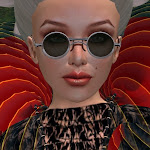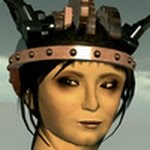Posted by Alpha Auer
There it stands, deceptively innocent, on the corner of Pavig and Littletoe's parcel at Popcha - a flat white panel; a beautiful drawing on one side, a beautiful poem on the other. Aaah... I have to work my way very carefully around this one, mind my steps... The wise thing to do would be to contact the artist and get the inside scoop and then proceed to write this post based on what I have learned.

But I am not wise: I am following the somewhat dangerous adage that if a visual work does not offer me enough to draw me in, based solely upon what I see, then it is probably not worthy of too much consideration to begin with. Perilously conceited of me, in our day of endlessly long art catalog introductions and reviews which instruct as to precisely what it is we are meant to see in a work of art and also how exactly we are meant to look at it. But nonetheless, I will follow my own nose: This double sided panel seems to tell me things and provoke thoughts that in all likelihood fall outside the intentions of the artist - and if that is indeed the case, then so be it.
...
The Ern Malley incident is a poetry hoax which occurred in Australia in the 1940's, involving the poets James McAuley and Harold Stewart, and played upon Max Harris, the publisher of the modernist Angry Penguins literary journal. Harris was indeed taken in by the beauty of the 17 poems that were sent to him by someone named Ethel Malley, proclaiming that these were poems written by her deceased brother Ern Malley. Thus, Harris enthusiastically promoted the poems in his journal, completely unaware of the fact that Ern Malley was an invention of McAuley and Stewart's. They had written the whole of "The Darkening Ecliptic" in an afternoon, writing down the first thing that came into their heads, lifting words and phrases from the Concise Oxford Dictionary, a Collected Shakespeare and a Dictionary of Quotations: "We opened books at random, choosing a word or phrase haphazardly. We made lists of these and wove them in nonsensical sentences. We misquoted and made false allusions. We deliberately perpetrated bad verse, and selected awkward rhymes from a Ripman's Rhyming Dictionary." Their ultimate aim was the discreditation of late modernist poetry, of which Max Harris was a huge proponent.
Although initially successful to the point where Max Harris was in fact completely discredited for not having been able to discriminate between hoax and reality, the passage of time revealed that the fictitious poetry of Ern Malley long outlived the poetry of either of the hoaxers. Robert Hughes wrote: "The basic case made by Ern's defenders was that his creation proved the validity of surrealist procedures: that in letting down their guard, opening themselves to free association and chance, McAuley and Stewart had reached inspiration by the side-door of parody... The energy of invention that McAuley and Stewart brought to their concoction of Ern Malley created an icon of literary value, and that is why he continues to haunt our culture."
...

The front of the panel shows a fine pencil drawing which brings to mind the panoramic engravings of cities during the late Gothic and Renaissance periods. And indeed, this one here is a very fine re-interpretation of Duerer's watercolor of Innsbruck. However, an Innsbruck constructed of organic shaped sculpties which are sandwiched between the panels and indeed bleed out into the back. Forms that are referenced from a medieval city's skyline but quickly proceed to acquire a life of their own - emergent, fluid forms of growth reminiscent of the biological drawings of Ernst Haeckel. But the fact that the template drawing generating such imaginative craftsmanship is none other than "Innsbruck 1495" leads us straight back to Ern Malley, since the first of the 17 Malley poems is entitled "Duerer: Innsbruck, 1495". And sure enough, the flip side of the panel reveals the poem itself:
"I had often, cowled in the slumberous heavy air,
Closed my inanimate lids to find it real,
As I knew it would be, the colourful spires
And painted roofs, the high snows glimpsed at the back,
All reversed in the quiet reflecting waters —
Not knowing then that Dürer perceived it too.
Now I find that once more I have shrunk
To an interloper, robber of dead men’s dream,
I had read in books that art is not easy
But no one warned that the mind repeats
In its ignorance the vision of others. I am still
the black swan of trespass on alien waters."
...
So, what is the secret message that revolves around Ern Malley which Pavig Lok would have me be riddled with? The piece is hermetic, which to me is one of its main attractions. I really do not want to know, I would prefer to live with the mystery. And I would really much rather go down my own path of musings which the piece has provoked in me, follow my own train of thoughts. Good art - really really good art, powerful art does that to you: It inspires you and so help me God, right now I am most definitely inspired!
...
A fictitious character, whose poetry outlived that of his two creators. And this brings to mind yet another creator of fictitious identities, the Portuguese writer Fernando Pessoa, with his countless heteronymic identities, creating a world of imaginary people, circumstances and places. The self that generates many selves. Some closer to what we perceive to be our real selves, some more shrouded in fiction. And who is to say what is more real? Reality or fiction? What is more valuable? The somewhat stilted verse of the twosome that created Ern Malley or Ern Malley himself, who unhindered by formality and convention proceeded on to a level of creativity, which was beyond the scope of the "real" persona of its instigators.
I am of course, talking about avatars and alts - the many many selves that we create out of our one self. The lives we create that proceed to develop acts of creativity that seem to lie beyond the scope of the imaginations of our everyday, Real Life selves. These days I am heavily involved with my 5th alt: No Real Life look-alike/act-alike Alpha but a being quite unlike myself, somewhat confusing to behold even to me, her creator. And yet who is to say which one of us is more real? Or indeed carries the greater potential for creative realization?
...
Thank you Pavig Lok!
...
You can teleport to Pavig Lok's "bfa after Durer - the Ern Malley piece" directly from here.
Wednesday, November 19, 2008
"bfa after Durer - the Ern Malley piece"
Posted by
Alpha Auer
at
2:00 AM
![]()
Labels: Albert Duerer, alts, art, avatar, Ern Malley, Ernst Haeckel, Fernando Pessoa, fictitious, literary hoax, modernist, NPIRL, Pavig Lok, poetry, Robert Hughes, sculpty, Second Life®, SL








4 comments:
Thanks for the kind review. You've certainly found and followed a lot of the threads I built into the piece. One thing that may not be obvious though (and you come tantalizingly close to it) is that, like Ern Malleys work, it was designed in the context and to look at art criticism.
As you mentioned, the Malley poems were written as an empirical test of Max Harris's reactions to a work constructed purely to be deconstructed by a critic. Our neighbors in Popcha are the wonderful Brooklyn is watching crew who do a weekly podcast on the SL art that people drop there. I tried to link a bunch of elements which they had talked about previously in podcasts in an enigmatic way, then give it some faux meaning via a link to Erns poetry... just to see what they'd say. :)
Obviously the joke was there for anyone who bothered to google the poem - a clear marker that the work is tongue in cheek. I'm glad you found the Robert Hughes quote however, as it reflects one of my convictions about art: that given a balanced treatment seemingly random and disparate elements can become linked in the mind of the artist/viewer and take on a life of their own.
Malley is also interesting as a fictional personality, and though I didn't explore that thoroughly in my focus, you rightly point out that just because our avatars don't "exist" in the sense that many folk imagine is important, that makes them no less real. If I had been cleverer with my experiment I should have submitted it as an alt, but unfortunately I thought of that too late and the BIW folk had already seen me making it.
My avatar is certainly more famous than my RL self though, and I do believe it has a life of it's own - my own really. Here in SL we are redefining the magic circle for a new generation. Tis an interesting experiment.
Hi Pavig!
Well yes, I did have an inkling that the panel addressed the practice of contemporary art criticism. However, I felt that what you have created far transcends that discourse and thus chose not to pursue that line of inquiry. However, had I done so I would most certainly have made mention of the Postmodernist Text generator:
http://www.elsewhere.org/pomo/
The generator has been used in a successful experiment, aimed at discrediting a particular type of academic writing prevalent in the Arts, Humanities and Social Sciences, by a preeminent French scientist - either a geneticist or biologist - who used it to create a completely meaningless essay, nonetheless pushing all of the correct buttons in terms of academic terminology, as this application inevitably does. The generated essay was published in a highly respected anthropological academic journal. And not only that, it also received numerous citations that were then duly entered into the Citation Index database - which is the feather scale on which all of our academic prowess is ultimately assessed. Unfortunately, I no longer remember the specifics, such as the names of the scientist or the journal, but this information was widely circulated via email in academic circles a couple of years back and I could find out I suppose, should you be interested.
;-)
If I am not mistaken the whole drawing is an exploded ant
Great piece, and great piece about it. :)
On the postmodern hoax, you're probably thinking of the Sokal hoax ( http://en.wikipedia.org/wiki/Sokal_affair ); the text in that incident wasn't actually generated by the pomo generator (which I doubt would have been accepted even by Social Text), but it had roughly the same amount of meaningful content.
Unlike the Malley poems, which I tend to agree are pretty cool. Not that I'm a qualified poetry critic. :)
Post a Comment